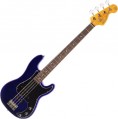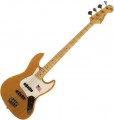Pickup diagram
Electric guitar pickup layout diagram. The letters used in this diagram indicate the types of pickups:
-
S - single. A single-coil pickup that looks like a narrow strip, often with a number of “buttons” (magnets) corresponding to the number of strings. Such modules provide clear and ringing sound, well suited for jazz, blues and other similar genres. On the other hand, the sound saturation from single-coils is not very high; they are poorly compatible with distortion and other similar effects, which is why they are poorly suited for “heavy” styles of music. In addition, such pickups are susceptible to external magnetic fields, which can degrade the sound.
-
H - humbucker. A type of pickup with two coils, originally created to compensate for the shortcomings of single coils - in particular, to reduce the level of interference from external magnetic interference. However, in the end it turned out that humbuckers differ noticeably in the color of the sound: it turns out to be less expressive, but more dense and rich, making it excellent for playing “overload” (distortion, overdrive, etc.). A classic pickup of this type has two coils positioned side by side, making it noticeably wider than a single coil; and Standard class humbuckers generally look like two single coils installed close to each other. However, in addition to this, there are other design options - for example, a hamcanseller
..., which has coils “on two levels” and is comparable in width to a single. Also note that there are humbuckers that can switch to single-coil mode (see “Coil Cutoff” for more details).
—J. A subtype of S-type pickups with one coil and an additional pole for each string. This variety first appeared on the legendary Fender Jazz Bass. J pickups have a versatile sound that suits almost any style of music.
—P. P pickups have two magnetized poles per string, but they have a unique feature: they are cut in half and wound in reverse. The advantage of this winding is the humbucker effect (see type “H”). The wide and long shape of the P pickup provides powerful and punchy sound in genres such as rock, metal, punk, etc.
- P90. A special type of single-spool single with a wider but shorter bobbin. These pickups are installed in the bridge or neck area of the guitar. Their distinctive feature is a characteristic “rock and roll” sound with warm, soft and rich timbres. Instruments with P90 pickups are often used in alternative rock, blues, indie, etc. styles.
The pickup diagram describes their types, number and relative positions. Our catalog uses a bridge-to-neck designation: for example, an HSS design means the guitar has one humbucker at the bridge and two single-coils near the neck.
This parameter determines, first of all, the overall color of the instrument’s sound. Thus, the above version of HSS will produce a sound that is quite clean and expressive, but at the same time a little denser and lower than on a purely “single-coil” electric guitar. There are many models available that are equipped with only one type of pickups. Moreover, the more pickups, the deeper and richer the sound, as a rule. In addition to all this, many other factors affect the sound of the instrument, so when choosing, you should not look only at the pickup circuit.Volume controls
The number of volume controls provided in an electric guitar.
If there is only one knob, this means that the musician can only adjust the overall volume of the instrument. However, there are models that have several volume control knobs — usually there are no less of them than pickups (2 or 3), which allows you to separately adjust the volume of each pickup. And since the characteristics of the sound depend on the type of the used pickup (see "Pickup Diagram") and even its location, then by changing the mutual volume of the individual pickups, you can achieve different coloring of the sound. At the same time, the design may also include a general volume control, which allows you to adjust it in the classical way and not mess with the settings of each pickup.
Pickup switch
A type of pickup switch used on an electric guitar.
This switch is responsible for turning individual pickups on and off, and can also control coil cutoff (see above). Accordingly, the manufacturer chooses its type primarily depending on the number of pickups (see "Pickup Diagram"). So, 3-position switches are typical mainly for models with two pickups — they usually allow you to turn on each of them separately or use both at once. The 5-position controls are common on 3-pickup models with stratocaster or superstrat bodies (see “Shape (Appearance)”). Note that the specific combinations of pickups available in such instruments may be different, this point will not hurt to clarify separately. The most advanced option — a 6-position switch — is extremely rare, mainly in expensive custom class instruments.
A separate type of switch is the balance control, used mainly in bass guitars (see "Type"). They are not responsible for turning off individual pickups (there are usually two of them), but for changing their volume relative to each other. Roughly speaking, these are two volume controls for separate pickups, combined in one knob (of course, there are also two pickups in such instruments). In fact, the balance control in this case also provides a smooth change in timbre: the pickup near the bridge picks up high frequencies better, the pickup near the fretboard picks up lower frequencies, respectively, and the colour of the sound changes depending on which of t...hem sounds louder.
Shape
The general shape of the body of an electric guitar.
The solid body of an electric guitar can be molded into almost any shape; hollow cases do not give such freedom, however, even among them, the options in shape can be very diverse. However, there are certain standard forms. It is not uncommon for these shapes to be named after a particular "legendary" guitar model, such as the "Les Paul" or "Stratocaster" (after Gibson and Fender instruments of the same name, respectively). It makes no sense to describe each standard form — it's easier to find an illustration in our catalog or on the Internet.
The main, and often the only point, which is affected by the shape of the body is the appearance of the guitar. Also, convenience for the musician to some extent depends on this parameter — for example, some models allow you to play while sitting, resting the instrument on your foot, for others this method is weak or not suitable at all. But whether the shape of the body affects the sound of an electric guitar is a moot point. There is an unequivocal dependence only in semi-acoustic models, but for solid bodies there is no clear answer to this question: some musicians claim the superiority of some forms over others, but this moment is largely subjective. In addition, other parameters (types and number of pickups, bridge design, etc.) greatly affect the sound quality.
Now on the market there are guitars with this body shape:
Les Paul,
Superstrat,
Stratocaster,
Jazz Bass,
Precision Bass,
Telecaster,
PRS Santana,
Flying V,
SG, however, there are also completely
non-standard options.
Case
The presence of a
case or cover included with the guitar.
Both the case and the case are tool cases, with the difference that cases are made of hard materials and provide better impact protection, while soft cases are more convenient to transport (especially on the shoulders). Anyway, the case is highly desirable for storing and carrying the instrument. It at least protects the guitar from dirt, moisture, temperature extremes, shocks and other adverse effects, and when carrying it, it also provides additional convenience: the design has appropriate devices for this, such as handles or straps. In addition, cases and covers often have additional compartments for accessories (spare strings, picks, notebooks, pedals, etc.)
The presence of a case in the kit saves the musician from having to buy it separately — especially since such an accessory is optimally suited to the "native" model of the guitar. The latter is especially important for custom-shaped cases, for which it can be very difficult to find separately sold cases. At the same time, complete cases / covers may not provide the required degree of protection — often these are the simplest products, designed mainly for warm weather without precipitation. So the characteristics of the complete case will not hurt to clarify separately.

